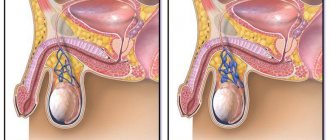An abortion should only be performed in a medical facility. Unfortunately, cases of criminal abortions are not uncommon. They are very dangerous. Criminal abortions account for 13% of maternal deaths worldwide.
But even an artificial termination of pregnancy in a clinic carries certain risks. The most dangerous procedure for reproductive health is curettage (scraping) of the endometrium. It can lead to infection or damage to the basal (growth) layer of the inner lining of the uterus. The result may be infertility after an abortion.
Does abortion lead to infertility?
Artificial termination of pregnancy often leads to serious, sometimes irreversible, consequences.
Infertility is not the only complication; cases of miscarriage, menstrual irregularities, and chronic inflammatory processes of the genital organs may also occur. The likelihood of adverse consequences is especially high after the termination of the first pregnancy at a young age. The risk of complications in such women ranges from 50 to 60%. Therefore, gynecologists recommend choosing the optimal method of contraception that will reliably protect against unwanted pregnancy. If suddenly an unplanned conception happens, do not delay your visit to the doctor. The shorter the gestational age at the time of artificial termination, the lower the risk of potential complications. The opposite statement is also true.
Diagnosis of pathology
It can be difficult to recognize a recurrent miscarriage even with the first episode of spontaneous abortion; it is even more difficult to suspect the risk of a recurrent abortion when the fact of the first pregnancy is established. The pathology is usually diagnosed after a second miscarriage that occurs at approximately the same time as the first.
After the first spontaneous abortion has occurred, the patient must undergo a series of studies that will confirm or refute the risk of developing repeated miscarriages. The following examinations are recommended:
- Gynecological ultrasound;
- Determination of immune status;
- Smear cytology;
- Hormone analysis when planning pregnancy;
- Blood test for Plasmodium malaria;
- Hormonal blood and urine tests;
- Reactions of Kahn, Wasserman, Sachs-Vitebsky;
- Study on group compatibility of partners;
- Determination of a woman's Rh factor;
- Hysteroscopy;
- Intradermal and serological tests for the diagnosis of listeriosis and toxoplasmosis;
- Measuring basal temperature over two menstrual cycles;
- Diagnostics of the blood coagulation system;
- Histology of endometrium taken before the onset of menstruation;
- Tests for sexually transmitted and viral infections.
Only a comprehensive examination will give a complete picture of the state of women's health and will allow us to find the factor that provokes a habitual miscarriage. If in the early stages of pregnancy it is possible to determine the risk of spontaneous termination and repeated episodes of miscarriages, competent and timely therapy allows you to save the embryo and bring the pregnancy to a healthy birth.
Why is this happening?
Infertility after abortion can develop due to various pathogenetic mechanisms.
In some cases, there may be damage to the basal layer, which ensures renewal of the endometrium in each menstrual cycle. In such a situation, gynecologists quite often have to deal with thin endometrium, into which a fertilized egg cannot be normally implanted. As a result, even despite conception having occurred, pregnancy does not occur (very early reproductive losses). In other cases, the process of proliferation of connective tissue may begin in the uterine cavity - adhesions form. This condition is called Asherman's syndrome. These connecting cords deform the uterine cavity and also disrupt implantation.
The third cause of infertility after abortion may be chronic inflammatory processes that develop in the genitals. Chronic endometritis does not allow the mucous membrane to fully prepare for pregnancy. This leads either to very early losses, which cannot even be detected biochemically, or to a missed abortion.
Types of abortions and timing
The risk of infertility after an abortion primarily depends on the method. In addition to traditional instrumental curettage, modern medicine offers alternative, more gentle techniques. These include:
- Vacuum mini-abortion. Can be performed up to 5 weeks of gestation. Does not require pain relief. A flexible plastic catheter connected to a manual vacuum aspirator is inserted into the cervix. Due to the negative pressure created, the fertilized egg peels off from the walls of the uterus and is evacuated out.
- Medical abortion. This is an abortion with the help of medications, which can be performed up to 9 weeks of gestation. First, the woman takes a drug that causes chorionic detachment, and then, after some time, takes a drug that increases uterine contractions and promotes embryo rejection. At this time, bleeding appears.
Compliance with the deadlines for artificial termination of pregnancy is an important condition that ensures the effectiveness of the method and its safety.
Impact of surgical abortion
Curettage is the most common abortion option, which is possible up to 12 weeks. This option is considered the most dangerous, since all manipulations are carried out using surgical instruments. When cleaning, the risks of damage to the body of the uterus are enormous, since curettage is carried out manually. It is considered the surest way to terminate a pregnancy, since the fertilized egg is completely removed.
Surgical abortion and infertility are quite often synonymous, since such an operation that traumatizes the uterus can cause scars and adhesions.
After curettage, it may become impossible for the egg to leave the ovaries, the percentage of risk associated with incorrect attachment of the fertilized egg during further pregnancies increases, and the risk of miscarriage increases when a normal one occurs. Miscarriage after curettage occurs due to the forced opening of the cervix - in the future it is simply not able to perform its functions fully. If pregnancy does occur after curettage, then possible scars on the uterus during the birth process can cause rupture of the uterine body.
The likelihood of infertility after an abortion
The chance of developing infertility after abortion is about 5% of cases.
This risk increases if artificial termination is carried out for a long period of time with curettage of the uterine cavity. Therefore, medicinal methods are more preferable, in which there is no injury to the uterine mucosa. To exclude damage to the endometrium as a cause of infertility after abortion, its three-layer structure in the first phase of the menstrual cycle and sufficient height (from 8 to 14 mm) on the eve of ovulation are crucial. In complex clinical cases, to assess the condition of the mucosa, hysteroscopy may be required - examination of the cavity and inner wall of the uterus using a special optical device. At the same time, diagnostic hysteroscopy can also serve as a therapeutic procedure. So, if there are pronounced adhesions, they can be excised, and then medications can be introduced into the uterine cavity to help restore it.
How to avoid infertility after an abortion
Firstly, in order not to encounter such a complication as infertility, it is important to choose the most gentle method of termination of pregnancy at the preparatory stage.
This is a medical abortion or mini-abortion. Surgical curettage carries the highest risk of complications. The choice of medical institution also plays an important role. You should trust your health only to trusted clinics that have implemented global protocols for providing medical care in the field of obstetrics and gynecology. The recommendations they contain have been verified through a series of clinical studies that have proven the highest degree of effectiveness and safety. Secondly, after an abortion, it is important to restore the correct hormonal profile in the body. It turns out that after a medical termination of pregnancy a stressful condition develops. The hypothalamus and pituitary gland are in the stage of excitation, and increased production of steroid hormones is observed in the adrenal glands, which causes corresponding changes in the ovaries and endometrium.
Thirdly, women undergoing an abortion should be observed by a doctor for 3 to 6 months. Only a specialist will be able to identify any, even minor, deviations in the functioning of the female body and promptly correct them.
Factors associated with medications and diseases
- A pregnant woman taking contraceptive, antitumor or hormonal medications not prescribed by a doctor.
- Taking non-steroidal anti-inflammatory drugs before conception and at the beginning of pregnancy. According to statistics, the frequency of miscarriages in women taking such drugs, spontaneous abortion was observed in 25% -30% of cases.
- Diseases of a hormonal nature: adrenal hyperplasia, polycystic ovary syndrome, premature decline of their functions, diabetes mellitus, etc. They are detected by taking hormone tests.
- Infectious diseases: bacterial vaginosis, toxoplasmosis, systemic syphilis. To identify diseases, you need to take vaginal smears and blood for infections.
- Chronic diseases of the lungs, heart or kidneys.
In addition, factors such as smoking, alcohol consumption, systemic exposure to radiation or toxins, gasoline, lead, etc. can cause a recurrent miscarriage.
Doctors say that most often, early miscarriage is associated with luteal phase deficiency - LPF (in this case, the corpus luteum in the ovary does not produce enough progesterone - the hormone that maintains pregnancy) and an increased level of the second hormone - hyperandrogenism (male sex hormone). This condition is easily identified and treated.
How is infertility treated after an abortion?
Treatment of infertility that develops after an abortion involves excision of adhesions, if any, as well as hormonal correction of the endometrium.
For this purpose, drugs are prescribed that simulate the menstrual cycle, i.e. first cause proliferation of the endometrium, and then its secretory transformation. In case of an infectious complication after an abortion, antimicrobial and anti-inflammatory therapy may be required. With significant damage to the uterine mucosa, the prognosis is not always favorable. Therefore, after an abortion, it is important to undergo full rehabilitation, which will restore the functional state of the endometrium.
Factors that cause infertility more often than abortion
Infertility after abortion is associated with significant damage to the endometrium.
However, this is not the only cause of impaired fertility. In the practice of a gynecologist, other etiological factors are more common. Thus, in every 5th patient the inability to conceive a child is associated with endocrine imbalance, which disrupts ovulatory mechanisms. Pathology of the fallopian tubes, in particular obstruction and compression by peritubar adhesions, occurs with approximately the same frequency. Ovarian diseases, endometriosis and uterine fibroids account for 10-20% of the causes of female infertility. Much less frequently (about 5% of cases) other factors occur - cervical polyps or scar deformation, genetic disorders and psycho-emotional disorders. Do not forget that in 20-30% of cases, infertility can be caused by male reasons - poor sperm motility, low sperm count and morphological inferiority. Therefore, in addition to the woman, the second partner should also undergo examination at the same time.
Advantages of treatment at SM-IVF
"SM-IVF" is a clinic that specializes in reproductive health issues.
Our center has introduced advanced medical advances that allow us to provide care at the most modern level. This guarantees a high degree of safety and the best therapeutic result. A personalized approach is applied to each patient, taking into account the characteristics of her body’s condition. Innovative diagnostic and treatment methods help make your cherished dream of becoming parents come true. The clinic guarantees complete confidentiality. SM-IVF specialists will conduct a comprehensive examination of the reproductive system and draw up an individual treatment and rehabilitation program aimed at quickly restoring fertility. We will help solve your problem based on the best global medical experience.
Where to get examined in St. Petersburg
If you suspect a miscarriage, you should immediately contact a gynecologist. You can get examined in St. Petersburg at the modern Diana clinic. We use a new ultrasound machine and other expert equipment. The cost of visiting a gynecologist is 1000 rubles. A comprehensive pelvic ultrasound will also cost 1,000 rubles.
CLICK TO SIGN UP
If you find an error, please select a piece of text and press Ctrl+Enter











